当前位置:
X-MOL 学术
›
Energy Environ. Sci.
›
论文详情
Our official English website, www.x-mol.net, welcomes your feedback! (Note: you will need to create a separate account there.)
K+ modulated K+/vacancy disordered layered oxide for high-rate and high-capacity potassium-ion batteries
Energy & Environmental Science ( IF 32.5 ) Pub Date : 2020-08-08 , DOI: 10.1039/d0ee01607a Zhitong Xiao 1, 2, 3, 4, 5 , Jiashen Meng 1, 2, 3, 4, 5 , Fanjie Xia 1, 2, 3, 4, 5 , Jinsong Wu 1, 2, 3, 4, 5 , Fang Liu 1, 2, 3, 4, 5 , Xiao Zhang 1, 2, 3, 4, 5 , Linhan Xu 6, 7, 8, 9, 10 , Xinming Lin 1, 2, 3, 4, 5 , Liqiang Mai 1, 2, 3, 4, 5
Energy & Environmental Science ( IF 32.5 ) Pub Date : 2020-08-08 , DOI: 10.1039/d0ee01607a Zhitong Xiao 1, 2, 3, 4, 5 , Jiashen Meng 1, 2, 3, 4, 5 , Fanjie Xia 1, 2, 3, 4, 5 , Jinsong Wu 1, 2, 3, 4, 5 , Fang Liu 1, 2, 3, 4, 5 , Xiao Zhang 1, 2, 3, 4, 5 , Linhan Xu 6, 7, 8, 9, 10 , Xinming Lin 1, 2, 3, 4, 5 , Liqiang Mai 1, 2, 3, 4, 5
Affiliation

|
With high theoretical capacity and applicable operating voltage, layered transition metal oxides are potential cathodes for potassium-ion batteries (PIBs). However, a K+/vacancy ordered structure in these oxides limits the K+ transport kinetics and storage sites so that the PIBs still have poor rate performance and low achievable capacity. Here, to effectively resolve the problem, a K+/vacancy disordered P3-type structure is designed and synthesized by simply modulating the K+ contents in Mn/Ni-based layered oxides. The effect of the K+ contents in a series of KxMn0.7Ni0.3O2 (x = 0.4–0.7) oxides has been systematically studied and it is found that while the K+/vacancy ordered superstructure is stable at low K+ content (x < 0.6), a complete K+/vacancy disordered structure forms at high K+ content (x > 0.6), evidenced by selected area electron diffraction and voltage plateaus in the charge/discharge curves. The K+/vacancy disordered K0.7Mn0.7Ni0.3O2 exhibits much better rate performance and higher discharge capacity, compared to the K+/vacancy ordered K0.4Mn0.7Ni0.3O2. Molecular dynamic simulations confirm that the K+/vacancy disordered structure possesses interconnected continuous channels for K+ diffusion and more active storage sites. This discovery sheds light on rational design of K+/vacancy disordered layered oxide cathodes for next-generation high-performance PIBs.
中文翻译:

适用于高倍率和高容量钾离子电池的K +调制K + /空位无序层状氧化物
具有较高的理论容量和适用的工作电压,层状过渡金属氧化物是钾离子电池(PIB)的潜在阴极。但是,这些氧化物中的K + /空位有序结构限制了K +的传输动力学和存储位点,因此PIB的速率性能仍然很差,可达到的容量较低。这里,为了有效地解决该问题,通过简单地调节Mn / Ni基层状氧化物中的K +含量,设计并合成了K + /空位无序的P3型结构。的K个效果+内容在一系列的K X的Mn 0.7镍0.3 ø 2(X= 0.4–0.7)氧化物已经过系统地研究,发现虽然K + /空位有序的上层结构在低K +含量下(x <0.6)是稳定的,但完整的K + /空位无序结构在高K +含量下形成(x > 0.6),由充电/放电曲线中的选定区域电子衍射和电压平稳期证明。与K + /空位有序K 0.4 Mn 0.7相比,K + /空位无序K 0.7 Mn 0.7 Ni 0.3 O 2表现出更好的倍率性能和更高的放电容量。Ni 0.3 O 2。分子动力学模拟证实,K + /空位无序结构具有互连的K +扩散连续通道和更活跃的存储位点。这一发现为下一代高性能PIB的K + /空位无序分层氧化物阴极的合理设计提供了启示。
更新日期:2020-09-16
中文翻译:

适用于高倍率和高容量钾离子电池的K +调制K + /空位无序层状氧化物
具有较高的理论容量和适用的工作电压,层状过渡金属氧化物是钾离子电池(PIB)的潜在阴极。但是,这些氧化物中的K + /空位有序结构限制了K +的传输动力学和存储位点,因此PIB的速率性能仍然很差,可达到的容量较低。这里,为了有效地解决该问题,通过简单地调节Mn / Ni基层状氧化物中的K +含量,设计并合成了K + /空位无序的P3型结构。的K个效果+内容在一系列的K X的Mn 0.7镍0.3 ø 2(X= 0.4–0.7)氧化物已经过系统地研究,发现虽然K + /空位有序的上层结构在低K +含量下(x <0.6)是稳定的,但完整的K + /空位无序结构在高K +含量下形成(x > 0.6),由充电/放电曲线中的选定区域电子衍射和电压平稳期证明。与K + /空位有序K 0.4 Mn 0.7相比,K + /空位无序K 0.7 Mn 0.7 Ni 0.3 O 2表现出更好的倍率性能和更高的放电容量。Ni 0.3 O 2。分子动力学模拟证实,K + /空位无序结构具有互连的K +扩散连续通道和更活跃的存储位点。这一发现为下一代高性能PIB的K + /空位无序分层氧化物阴极的合理设计提供了启示。


























 京公网安备 11010802027423号
京公网安备 11010802027423号